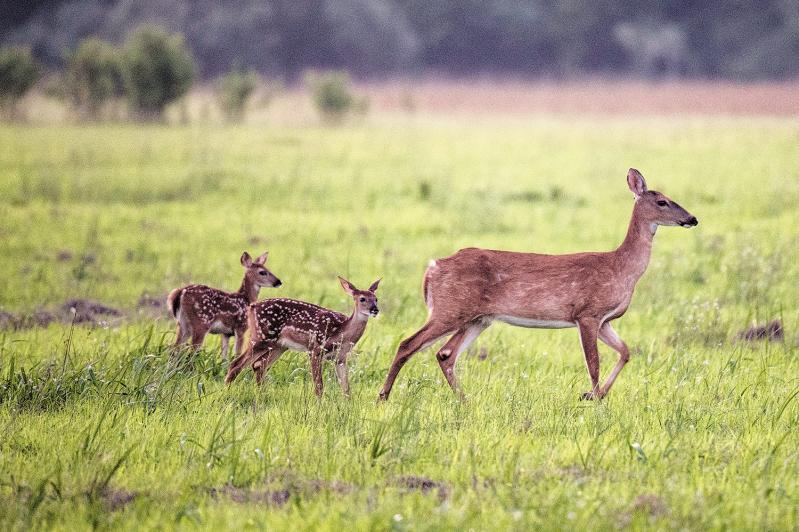Did you know that according to the Encyclopedia Britannica there are 43 different species of the deer family, Cervidae, worldwide? Most everyone knows the American moose, elk, reindeer, local white-tailed deer, and mule deer of the northwestern United States. If you spend part of each year in southern Florida you have probably read about the endangered key deer, a threatened subspecies of the white-tail. The largest member of the family is the moose; the smallest and one of the rarest a dear that stands less than two feet high at the shoulder and lives in South America, the diminutive pudu of the Andes.
I grew up on the North Fork and saw fewer than five living deer there between birth and graduation from high school. According to deer biologists, 100 years ago there were fewer than a million deer in North America, now there are more than 100 times that many.
I was going to study engineering at Cornell, but switched to wildlife conservation before I arrived for my first class. I was good in math, but I loved wildlife more, so I made the right choice. Ever since taking my first class at Cornell in 1953 and except for a stint in the Army, I have been involved with wildlife in one way or another.
Deer hunting season for bow hunters on Long Island starts on Oct. 1, and for shotgun and muzzle loader hunters on January 1. Last year, as far as records filed with the New York State Department of Environmental Conservation are concerned, 227,787 deer were taken by hunters in the state, of which 113,385 were adult males, 80,584 adult females, 17,359 male fawns, and 16,459 female fawns. About two-thirds of the take was by firearms, a third by bow and arrow. Coincidentally, another 20,000 or so were killed by motor vehicles. Wasting disease, which has sharply reduced deer populations in other states, has yet to strike New York.
Since the time when I graduated in wildlife conservation, deer management methodology has come a long way and in a sense the terminology has borrowed heavily from agriculture. Deer are now “harvested,” and the number of deer before the hunting season is often referred to as the “standing crop.” In other words, it sounds as if deer have become objects in the eyes of game managers and that there is very little in the way of feeling or empathy for the annual deer take. It has become more of a business than an ecological science.
I was both an avid hunter and a bad shot in my youth. I started with the BB gun and worked my way up to shotguns, and only once did I use a rifle. I still have three shotguns, a Winchester pump and Fox double barrel, both 12 gauge, and a pump 410 gauge. I haven’t fired a shotgun in 60 years. They stand together side by side in a closet.
Because the deer population throughout the state, but particularly in its suburban areas and on Long Island, was multiplying so rapidly, a doe season was initiated shortly after the beginning of the new millennium. Before then females were protected by law. After all, without them the American deer herd would dwindle at a rapid rate.
There are more humane ways to cull a population without resorting to slaughter, but they are complicated and costly, so game managers opted for the taking of females. Unfortunately, as staff examined the bodies of harvested deer throughout the state they discovered that a good percentage of them were fawns, not adults. It is not easy for the man or woman drawing a bow or sighting a rifle to tell the sex and age of a deer from 200 feet or so. That is why the “with horns” standard worked for so long, but it was ultimately abandoned. In fact, among many game managers a bias for female over male deer has come into practice. In fact, when you compare fawns taken to adults, you see that they represent nearly 15 percent of the total take.
The bias against deer is growing to the point where some deer-control companies employ tactics like tranquilizing a doe and removing its ovaries, as once practiced right here in East Hampton Village. Another tactic is to use a team of deer sharpshooters from the United States Department of Agriculture or a similar organization, who can use special lights and attack at night. We know that the former method is bloody and inefficient; the latter method has yet to be tried locally.
Taken collectively, these methods of reducing the deer herd remind me of some of the great human purges of the past and present, such as those in Europe by the Nazis in the 1940s, by the Cambodians in the late 1900s, and more recently in Sudan and Myanmar.
While many of us are bending over backwards to work out peaceful and more humane means of controlling populations — say, as in humans using birth-control pills — we are resorting more and more to brutal means of controlling the deer population. Ironically, at the same time we have practically put an end to whaling worldwide and increased the populations of endangered species such as condors, whooping cranes, trumpeter swans, bald eagles, and a host of others. Yet, the killing of elephants and rhinoceroses for their tusks and horns and pangolins for their scales continues.
As Pete Seeger wrote at the end of one of his antiwar songs, “When will we ever learn?”

